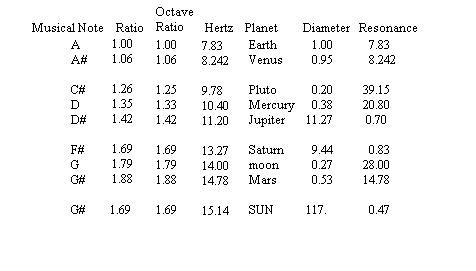
| FREQUENCIES AND SOUND 
Planet Circumference Correlated to Light and sound :
This data does correspond more or less to standard colors assigned to the planets.
Sidereal Orbit of Planets in Light and Sound :
This is calculated using the time it takes each planet to orbit the Sun. This is heliocentric data, not apparent movement from the earth. Traditional Astrology is based on geocentric (earth based) movements.
Colors here to do not match standard colors associated with planets :
Frequencies, Sounds and Noise :
Loudness is measured in decibels (dB) which is measured by a dBA filter, which closely matches how the human ear absorbs sound. Acousticians sometimes use other scales, such as dBC, which includes low and very high frequencies that human ears cannot register.
Type of sound and Level of Decibels (dB) :
Human threshold of hearing : 0 dB
Very quiet nature sounds : 10 dB
Whisper : 20 dB
Inside a sound-insulated recording studio registers : 20 dB
Living Room : 40 dB
Quiet Office : 40 dB
Lobby of Office Building : 55 dB
Air Conditioning Unit : 60 dB
Conversational Speech : 60 dB
A loud telephone ring : 70 dB
Train Station : 64-75 dB
Riding a Train, rumbling : 75 dB - 86 dB
Alarm Clock (1 Meter) : 80 dB
Hair Dryer : 80 dB
Train Braking : 95 to 98 dB
Full power earphones : 100dB
Front row at Rock Concert : 110 dB
A jet engine : 120 dB
A loud rock concert : 120 dB
Painfully loud : 120 dB
Thunderclap : 130 dB
Air Raid Siren, 1 Meter away : 130 dB
Rocket Launching : 180 dB
Threshold of Death : 180 dB
"The U.S. Army Medical Department ominously lists 180 dB as the threshold of death, the point at which sound can cause fatal injuries. Pressure waves generated by explosions or weapon noise, for instance, can rupture air-filled organs, such as lungs." Protect your ears OSHA Daily Permissible Noise Level Exposure.
Perceptions of Increases in Decibel Level : Imperceptible Change : 1 dB Barely Perceptible Change : 3 dB Clearly Noticeable Change : 5 dB About Twice as Loud : 10 dB About Four Times as Loud : 20 dB Sound Levels of Music : Normal piano practice : 60 -70 dB Fortissimo Singer : 3' 70 dB Chamber music, small auditorium : 75 - 85 dB Piano Fortissimo : 84 - 103 dB Violin : 82 - 92 dB Cello : 85 -111 dB Oboe : 95-112 dB Flute : 92 -103 dB Piccolo : 90 -106 dB Clarinet : 85 - 114 dB French horn : 90 - 106 dB Trombone : 85 - 114 dB Tympani & bass drum : 106 dB Walkman on 5/10 : 94 dB Symphonic music peak : 120 - 137 dB Amplifier, rock, 4-6' : 120 dB Rock music peak : 150 dB Notes :
Energy and Sound :
The
energy of a wave is determined by a unit called intensity of a sound
wave. "The greater the amplitude of vibrations of the particles
of the medium, the greater the rate at which energy is transported
through it, and the more intense that the sound wave is * "Intensity
is the energy/time/area; and since the energy/time ratio is equivalent
to the quantity power, intensity is simply the power/area.
We don't hear sounds at the same decibel level the same way. The rumble of a train is a mixed noise spread over many frequencies that blend together and due to the wave patterns, can even cancel each other out - much like ripples in a pond. With a purer tone, the energy is strong strong with much less interference from other noise. "Intense pure-tone sounds are more annoying."
Continuous sounds over about 85 dB can result in hearing loss over time :
Loud sounds put too much pressure on the cochlear hair cells, which can damage or kill them. Once dead, they do not regenerate, so hearing is permanently affected.
About 10% of Americans have some hearing lost, with one in three of them over the age of 65. Deafness can be across all spectrums of sounds or can be deafness only to certain frequencies - including some patterns with deafness to the higher frequencies of children's and women's voices.
"The World Health Organization (WHO) estimates that 50 percent of deafness and hearing impairment is preventable."
The human ear is most attuned to frequencies between 1,000 to 4,000 Hz, the range is from 20-Hz to 20,0000 Hz. Younger people are better at hearing the more extreme frequencies.
Animals highest normal frequency heard : Humans* : 20,0000 Dogs : 45,000 Hz Mice : 91,000 Hz Bats : 110,000 Hz Dolphins and porpoises : 150,000 Hz
Conversion of dB to Hertz :
1 kHz : 0dB
10 kHz : 2.5 db
Sound and Health :
"A sound that is interpreted as noise, as something we don’t want to hear, causes stress which causes problems with the heart, the gut, and other organs." |